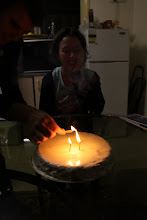Sanderson, Anna. “Brainpark” and “Haesje van Cleyburgh” from Brainpark. Wellington: Victoria University Press, 2006: 9 – 16.
It seems fitting (and I’m guessing not entirely coincidental) that the final words in the reader, that has guided these blogs for this year, might be used as an eloquent metaphor for thinking about the importance of reading theoretical material as a creative practitioner. The final words are as follows: ‘As long as you keep looking, she keeps forming and reforming’ (Sanderson, 16).
Writer and one-time artist, Anna Sanderson, in her essay from Brainpark, is here referring to the process of looking at a painting of the woman Haesje van Cleyburgh by Rembrandt. The words guide the reader to think about the work perhaps, more than anything, as a series of shifting possibilities. Formally, flesh has the possibility of a double life as a ‘swirl of greenish yellow, a quietly roaring pink, a murky brown orange’, while what is signified slips between the fingers or oscillates between ‘something humbled’ in her character and something ‘superior’. It seems that this slow and contemplative process of ‘forming and reforming’ sits in relation to the gathering and dissipation of relationships and connections; how one positions one’s body, how the woman’s character unfolds and then collapses again in relation to the time it takes to look at her, how the work appears the same or somehow different with each visit.
Though the excerpts from Sanderson’s Brainpark stand out as probably the most strikingly different in style from the other parts of the reader, this final sentence is a reminder that ‘with time, the development of relationships is inevitable. Entanglements occur.’ (Randerson, 242). The positioning of this piece of writing within the context of the reader is sensitive to the possibility of a development of relationships outside of the piece itself. In this sense, though the Brainpark excerpt comes at the end of the reader, and the excerpt itself is taken from the beginning of a larger work, in terms of a set of relations that the practice of reading for creative practice establishes, this piece of writing may well later be found reformed in a centre, below a surface, at a periphery, at a beginning or at an end.
Works Cited
Bywater, Jon., ed. Critical Studies Reading Group Readings 2008: FINE ARTS 756 &790, PGDipFA & BFA(Hons). University of Auckland: April 2008
Randerson, Jo "Everything We Know" in Are Angels OK?: The Parallel Universes of New Zealand Writers and Scientists. Callaghan, Paul and Bill Manhire (ed.s) Victoria University Press, 2006: 237 - 255.
Sanderson, Anna. “Brainpark” and “Haesje van Cleyburgh” from Brainpark. Wellington: Victoria University Press, 2006: 9 – 16.
Subscribe to:
Post Comments (Atom)

No comments:
Post a Comment